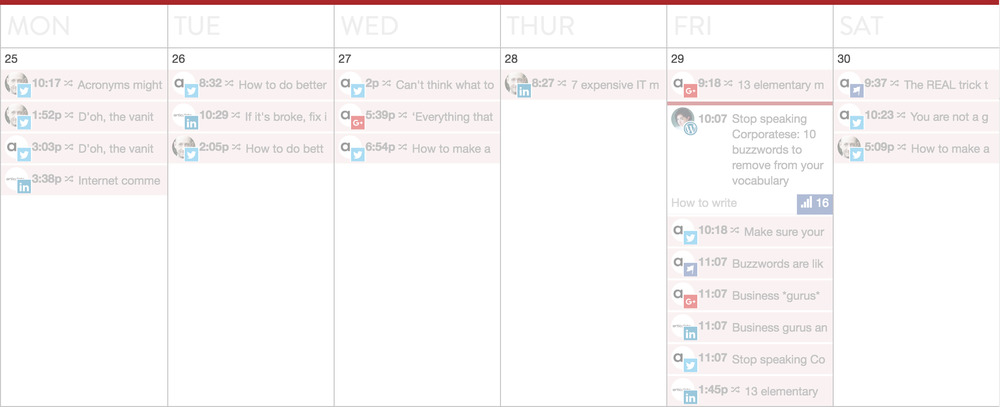An editorial calendar is like a roadmap for content creation; it tells you what, where and when to publish and which personas you should be targeting. By creating an editorial calendar you can:
- Marshal your authors and topics.
- Keep a record of keywords and call-to-actions you’ve used.
- Ensure that your content is delivered on time and on target.
First, you need to carry out an audit of past content and establish which topics and keywords have been the most popular. Then, using your buyer personas, you can create a three-, six- or 12-month editorial schedule encompassing all relevant content: blog posts, informational videos, white papers, tweets, Facebook posts, etc.
Consider creating monthly themes or rotating the focus between personas on a weekly or fortnightly basis. Overall, you are looking for a consistent and logical stream of content that keeps your audience coming back.
Cultivating inspiration
Start with one arresting idea, the narrower the better, and build from there. Whatever your body of collateral will be, imagine it forming the contents of a magazine. Picture the cover and work backwards from there, to the content you want to run through that edition. Distilling your ideas down to a magazine cover will help you craft your structure and theme.
Coming up with that brilliant, fresh and relevant idea is the hard part. Look at the calendar of events in your buyer personas’ fields. In business, for example, you have Small Business Week, Fair Trade Fortnight, Davos and so on. Know what your readers are doing and where they are going in order to address topical content.
A particularly good place to spot hot topics is social media feeds like Twitter. Follow your ideal readership, thought leaders and news outlets, and keep on top of current trends.
Also, read as widely as possible, particularly in American and Asian news, in order to watch for emerging trends, which can be adapted for your audience. Ideally you want to be just ahead of conventional wisdom.
Ideation for your content calendar
Once you have an idea of the general topics of interest and concern you want to cover you can start to hone in on specific topics.
- Your obvious is your talent. Find something that you do everyday that may not be obvious to other people and write about that.
- Ask why. Pick a topic and speculate on why it happens.
- Ask how. Ditto but how!
- Interview someone.
- Start a campaign. Find something objectionable (in our case lazy writing) and keep citing examples of it until change occurs.
- Find a role model. Who writes well? Who do you admire? Praise them. The media is full of negative stories but it’s your blog, so write a positive one.
- Expand on someone else’s idea. The blogosphere is a conversation. Take something (with attribution) and add your own original thoughts.
- Cartoons. Sketches, diagrams. Anything that makes your point without words.
- Build on a phrase. Sometimes a small phrase pops into your head and it can inspire a whole article. Listen to your inner voice.
- Try HubSpot’s topic generator. Not always perfect, but a handy tool for getting into the rhythm of catchy blog titles. Enter three words and see what it comes up with.
Don’t let good ideas slip away
Coming up with blog post titles and ebook outlines all in one sitting can be daunting, if not near impossible. Give yourself something to work from by keeping a regular note of customer queries, news stories, data points and brainwaves as they come to you.
Some people prefer old-fashioned notebooks, but there are plenty of online options too. Personally, we like Microsoft OneNote. It lets you create notebooks with dividers and tabs, enter text, images, URLs, screengrabs, audio recordings and more on a freeform page. You can drag items around on the page freely so it feels less linear than a word processor. In combination with OneDrive, you can share notebooks online and access them on iOS and Android devices.




